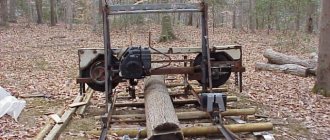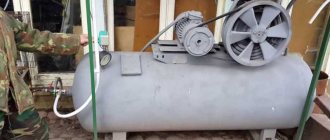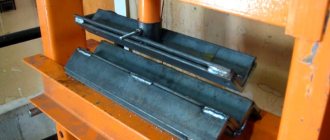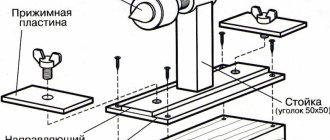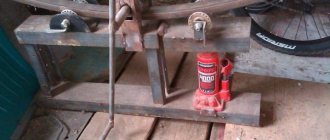A pipe bender is a device using a mechanical or hydraulic operating principle for bending pipes, angles, rods and other metal products. It is possible to make a pipe bender for a profile pipe with your own hands, which allows you to bend most types of profiles.
There are several main types of pipe benders: volute, manual roller and jack. It’s more difficult to make hydraulic and electric models yourself, so let’s look at mechanical models.
Required Tools
To assemble a pipe bender, you need at least the following tools:
- welding inverter;
- angle grinder;
- lathe (or purchase of finished parts);
- vice;
- hammer;
- metal file;
- sandpaper;
- ruler;
- drill.
But the most important thing is the pipe bender drawings. The mechanism must be manufactured strictly according to the drawing. You can take a ready-made drawing from this material or find another one and adapt it to the required dimensions.
But it is impossible to make a pipe bender without a drawing, since precise calculations are needed to ensure the operation of the mechanical parts.
Frame design
Having decided on the center distance and the design of the rollers, you can mark the blank parts for the frame. Based on the experience of FORUMHOUSE users, it should be concluded that the strongest frames are made from steel channels (at least 80 mm wide). This material is easy to get, so you can safely take note of it.
The photo shows the machine at the manufacturing stage. And here is the drawing that is taken as a basis.
Person User FORUMHOUSE
During the work, some changes were made to the original drawings.
The presented drawing is not a mandatory guide to action, but provides an objective understanding of how a rolling pipe bending machine works.
Materials for volute pipe bender
When making such a pipe bender with your own hands, the dimensions of the parts must be selected to suit individual needs, since this model does not have a specific working diameter. This is also an advantage, since it allows the use of available materials.
To assemble the structure you need:
- meter channel;
- Sheet steel;
- 3 shafts;
- 2 stars;
- steel chain;
- 6 bearings;
- a two-meter pipe with a diameter of 12.7 mm for the production of knobs;
- screw for clamping;
- bushing with internal thread.
The structure of a pipe bending machine and instructions for its assembly
In the process of producing various types of metal structures, a special machine is used for bending profile pipes, which is a compact and easily transportable equipment with different types of drives.
The unit is lightweight and easily copes with the task of bending cold rolled metal. And to achieve optimal curvature, special attachments are used together with a pipe bender for processing various types of metal products.
To learn how to operate such a unit, it is important to study the features of its design and the basic principles of operation.
The pipe bending machine consists of the following elements:
- supporting frame made of high-strength metal profile;
- three rotation shafts located on separate axes and responsible for the process of bending the profile pipe to the actual bending angle;
- mechanism for rotating working shafts;
- chain for connecting elements of the drive mechanism.
Manual machine for bending reinforcement.
All factory and home-made bending machines are divided into four types, depending on the system of arrangement and functioning of the rollers:
- Units with an upper movable roller are the simplest option in terms of the mechanical component. In the design of such a profile bender, only the upper roller can move, and the roller can be hydraulic or upper manual. This structure provides the master with the opportunity to accurately calculate the possible radius for bending metal parts with a minimum error due to metal additives or a slight gradient during profile deformation.
- Equipment with a left roller can perform the same functions as machines with a top movable roller. But, in addition to this, it is excellent for curling spirals, which the first type of profile benders cannot do. You can choose a model equipped with CNC to control the bending gradient.
- Units with lower rollers are suitable for bending large profiles, thanks to the even distribution of bending forces on the two lower shafts and a fully hydraulic drive mechanism. Each video has its own location controller.
- Roll benders with all moving rollers are distinguished by the most complex mechanism, which allows them to accumulate the advantages of all types of such equipment.
On a note! Such equipment differs in size, marking, cost and weight. But for domestic use, a homemade profile bender is also suitable, the production of which will cost the craftsman a little money.
Drawing
The initial task when making a bending machine for a profile pipe on your own is to create a drawing of the bending machine. You can compose it yourself or find it ready-made on the Internet.
On numerous forums of craftsmen and craftsmen working with metal structures, you can find videos with a detailed description of the structure of a pipe bending machine and instructions for its assembly.
Assembly
After preparing a drawing for a homemade pipe bender, you can begin assembling the supporting frame. If you plan to use the equipment for a profile pipe with your own hands, then you should avoid using welding when assembling the frame.
Pipe bender design.
This method of connecting parts will not provide the machine with the maximum level of reliability. It is better to give preference to bolts, which will give the unit strength and mobility: if necessary, the structure can be disassembled.
Next, the working shafts are mounted on the pipe bending unit: two are slightly above the work table top, the third is above them. To fix the bearings, crescents made of 4 mm metal are used.
After installing the working shafts on the frame, their rotation mechanism is assembled from three sprockets and a chain: two of them are mounted on both lower shafts, and the third below.
Important! It is definitely worthwhile to provide for the possibility of changing the position of the lower sprocket, which will allow you to easily tension the chain on the roll forming unit. For easy operation of the equipment, fix a durable handle on one of the sprockets.
Be sure to test the profile bending machine after assembly to eliminate the risk of defects.
Manual pipe bender on a roller mechanism
Making a manual pipe bender on rollers with your own hands is somewhat easier, since there are fewer mechanical elements. The device allows you to bend pipes in certain places.
The device must have a long lever, since direct manual force is required to bend the products.
Classification by drive type
The motor is equipped with quite powerful models, which, in the factory version, are actively used in production. But such equipment can also be assembled personally (based on drawings and diagrams) for subsequent use in a home workshop. Essentially, you will get a machine that looks like this:
- Hydraulic – stationary, powerful, designed for diameters from 3 inches. It is best suited for industrial facilities, as it allows for large-scale work to be carried out with a high degree of productivity.
- Electromechanical is a good choice for bending main elements. It is convenient because it can be used to calculate with maximum accuracy both the optimal clamping force and the required angle.
- Manual – focused on small sections and low intensity of use.
Materials for making a roller pipe bender
To assemble the mechanism you need:
- 2 steel rollers 10 cm and 6 cm in diameter. Inner radius – 12.7 mm, thickness – 35 mm;
- 1.5-inch thick-walled (from 3 mm) steel pipe for constructing a lever (length from 1.5 m);
- 4 steel strips 15x6 cm, about 5 mm thick. The mechanism for fastening the device in a vice. Also used for the construction of handles and lever supports;
- steel strip 6 cm wide and 3 mm thick;
- 2 bolts – 60 mm 17.78 mm and 40 mm 12.7 mm. For fixing the rollers;
- steel plate 30x30 cm (thickness from 3 mm);
Device options
If you make it yourself, your hands are free. For example, nothing prevents you from implementing a lever-type installation so that the force is concentrated at a certain point, making it easier to ensure the desired radius of curvature. This configuration allows you to create templates that can be easily removed and replaced with others. Let there be 2–3 of them - for rolled products of different diameters.
The mechanism can also be crossbow or drone, that is, as compact as possible, designed for short sections of pipes. It will be very convenient during installation, when laying communications, in confined spaces.
Manufacturing a manual pipe bender on a roller mechanism
How to make a pipe bender with your own hands at home - step-by-step instructions:
Make 2 holes with a diameter of 12.7 mm and 17.78 mm at an interval of 80 cm (or other, based on your drawing). The frame has a 19.05 mm hole. Install the appropriate bolt into it and secure it with welding.
Weld a U-shaped part from 15x6 cm plates, a 12.7 mm bolt, a small roller and a 35x60 cm strip of steel. Pre-mount the roller using a bolt in the previously prepared holes. Weld the bolt to the plates. As a result, you will get a product that resembles a spear.
DIY fan: how to make a homemade powerful fan. Basic parameters and properties of fans (130 photos)- Why do you need a security alarm, what functions does it perform?
How to choose winter workwear and not make a mistake - recommendations from the pros
Weld a tube that acts as a handle to the base of the assembled part. Weld the pipe support strip to the base of the entire product. Between the bar and the main bolt there should be a distance equal to the radius of the main roller (which has a larger size according to your drawing) with an addition of 12.7 mm.
At the bottom of the base, weld a 15x6 cm strip, with which the structure is secured in a vice. Mount the main roller into the rod part. Place the latter on the main bolt and secure with a nut. Secure the device in a vice and test it in action.
How to bend a profile pipe without a machine
There are two ways to make an arc from a profile pipe without a profile bender - using welding and a template. Let's start with welding.
Get an arc by welding
The profile pipe is cut with a grinder on one side. They are made every 15-30 cm, depending on the required radius, cross-section and wall thickness. The cuts should not touch one side - the one that will be on the outside.
Result of bending by welding
The spare part prepared in this way is bent, giving the desired bend. For reliability, the edges of the arc can be fixed by welding a rod to them. Then welding is carried out along all the cuts, welding them. And the last stage is grinding the weld spots and treating them with anti-corrosion compounds.
Using a template
Thin-walled profiled pipes can be bent by hand using templates. If you need a special shape, it can be cut out of a piece of thick plywood or chipboard and secured to the table using clamps. On the workbench where we will bend the pipes, make about 8-10 holes. The template is placed near these holes.
The process of obtaining an arc from a profile pipe using a template
The holes are repeated at one end of the pipe; with their help, the pipe is attached to the workbench. Now the free end of the pipe begins to be pulled smoothly, forming a bend that follows the shape. You need to pull smoothly, without jerking.
The template can also be made on the ground. Pipes-pegs are driven into the ground (at least half a meter deep). They form the required arc. For emphasis, two additional stakes are driven in, which are located to the side of the arc. The distance you need to step aside is slightly greater than the width of the pipe.
Pattern on the ground
Having inserted the pipe, it is pulled towards the arc. Great efforts are required, the work is hard. This can only be achieved with a thin-walled, seamless pipe. The suture has too much resistance in the seam area. It is very difficult to overcome it manually.
Jack pipe bender
A simple and convenient device for bending profile pipes. For production you need the following materials:
- jack;
- 4 corners 40 cm long with equal shelves of 50 mm each;
- 2 rollers with grooves for belts. There should be through holes in the center. If they are missing, drill, measuring the middle;
- equipment for a jack in the shape of a semicircle with a recess inside;
- 2 channels 60 cm long and 10 cm wide;
- bed;
- 2 mounting bolts.
Construction of a pipe jack bender
Weld the corners vertically onto the station. Make holes in the channels for installing rollers.
Weld channels onto the corners (2 corners - 1 channel). Place the channels with the platforms facing each other. The spacing between parts should correspond to the length of the rollers. Mount the rollers in the prepared holes and secure with bolts.
How to choose an air conditioner for your home or apartmentDo-it-yourself bait - composition, application features and storage methods (115 photos and videos)
DIY sliding gates - how to build simple and automatic gates. Schemes, drawings and review of the best ideas (90 photos)
Mount the equipment in the shape of a semicircle on the jack and place it in the central part of the base between the channel structures.
Next, lay the pipe at the bottom of the rollers and press it using a jack. As you press, the pipe will bend into the required position.
Classification by bending method
Based on the nature of the profile impact, the following types are distinguished:
- Segmental - pulls the workpiece through a series of rollers, each of which has its own effect and changes the geometry.
- Crossbow - its main element is a device that sharply moves forward, bending the fixed rolled product along the required radius.
- Spring - equipped with grips that straighten and bend the structures being held (if they are made of not the most durable material, for example, plastic).
When performing work, say, assembling a frame for a country greenhouse, you should not chase big corners. Remember, the more you deform the part, the more likely it is to break under load.
Well, now let's move on to the features of creating the simplest mechanisms.





